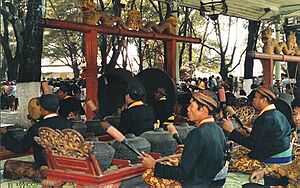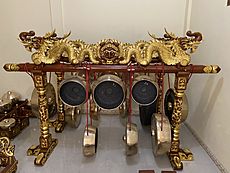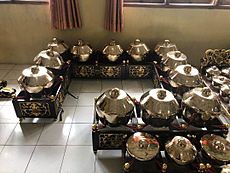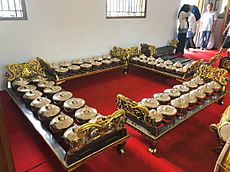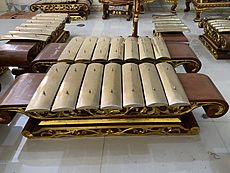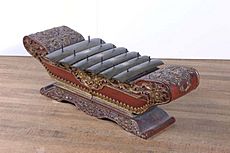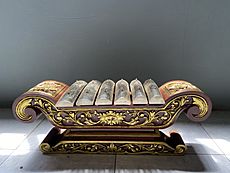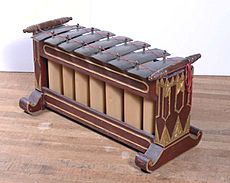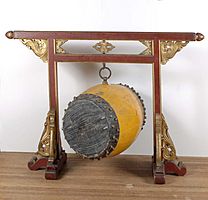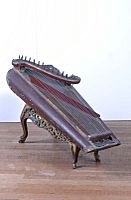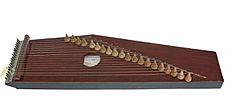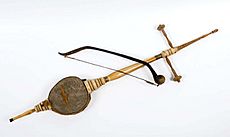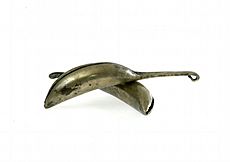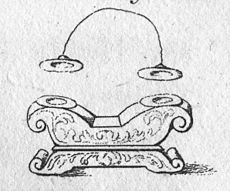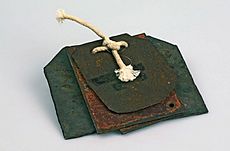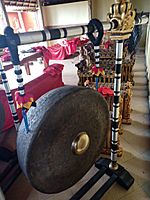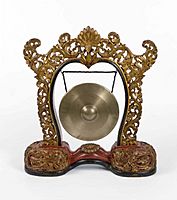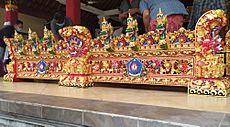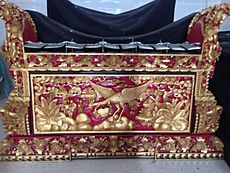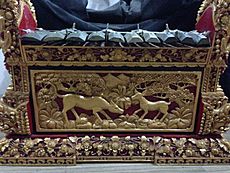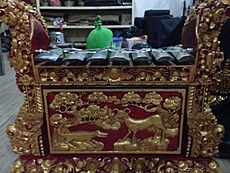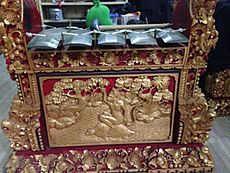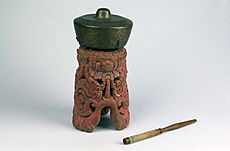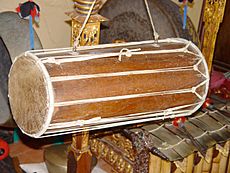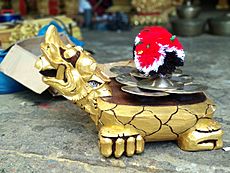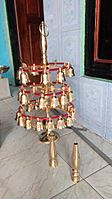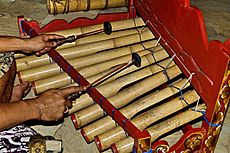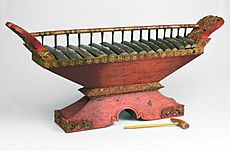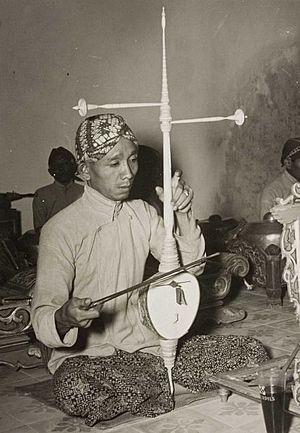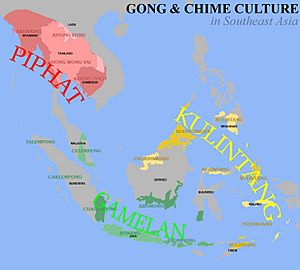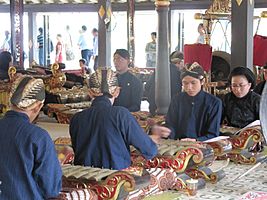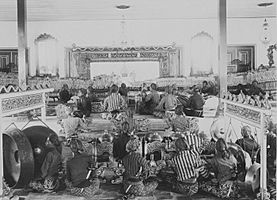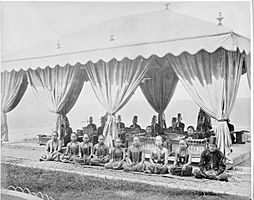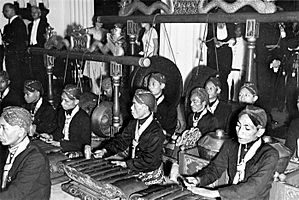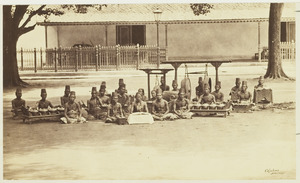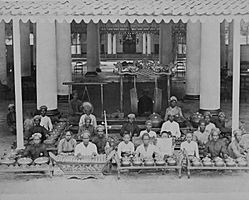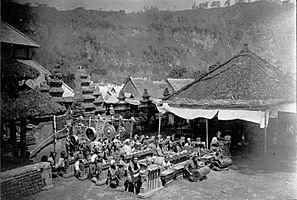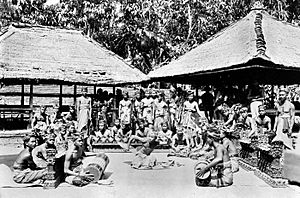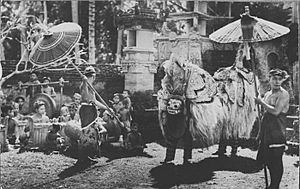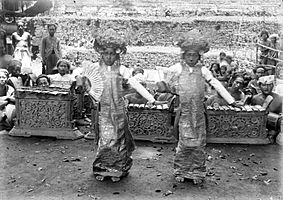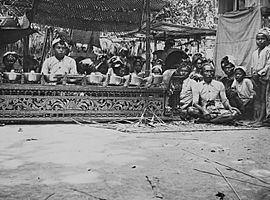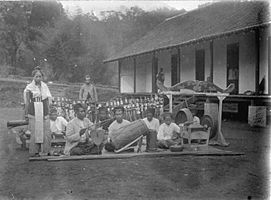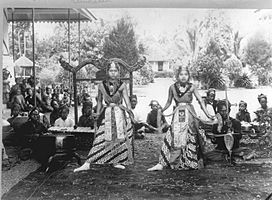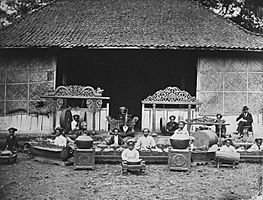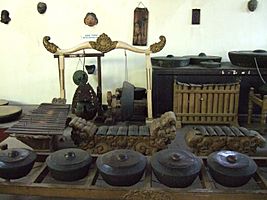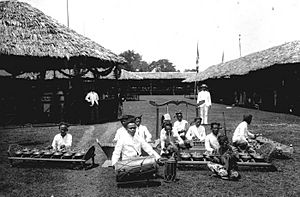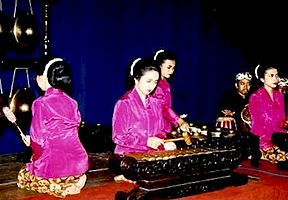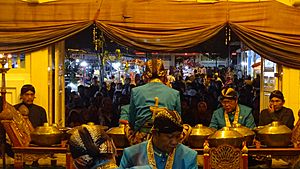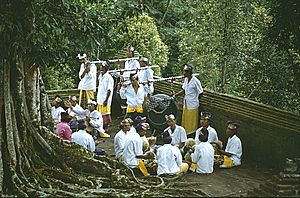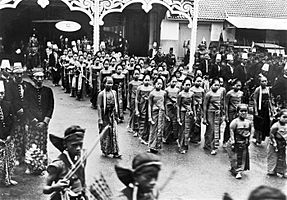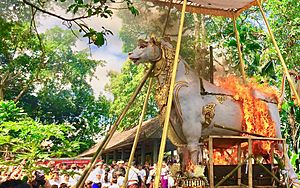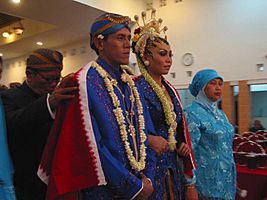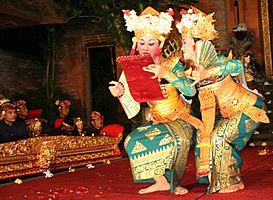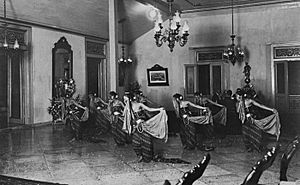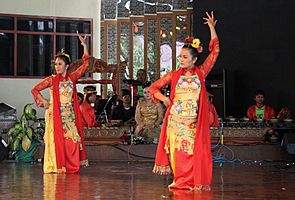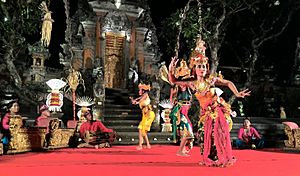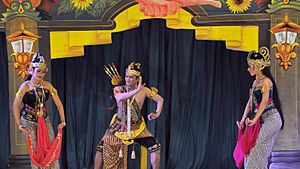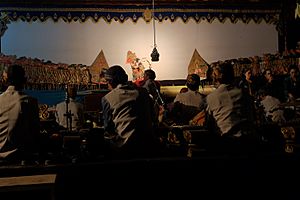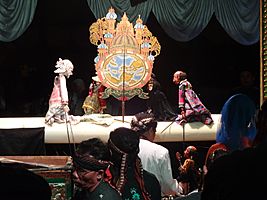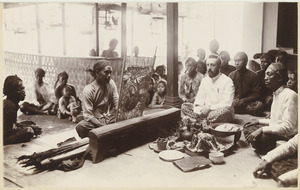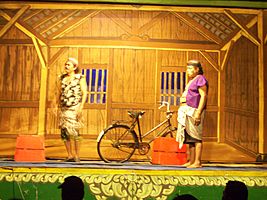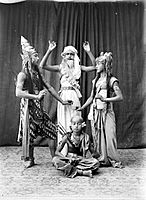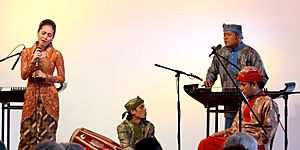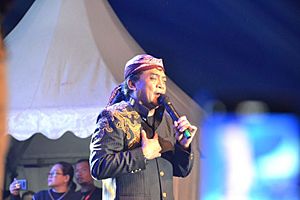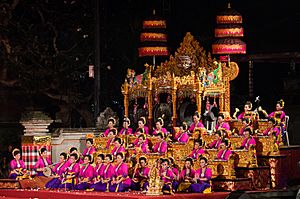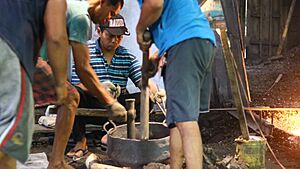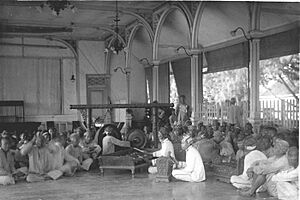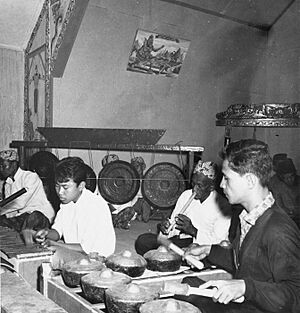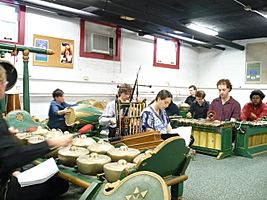Gamelan facts for kids
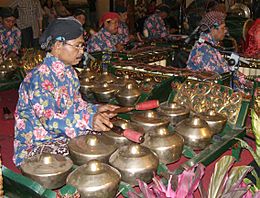
A gamelan player playing bonang. Gamelan Yogyakarta style during a Javanese wedding.
|
|
| Classification |
|
|---|---|
| Developed | Indonesia |
| Playing range | |
| Pelog, Slendro, Pathet, Cengkok, Seleh, Sekaran, Imbal, kotekan, Gatra, Colotomy, Gendhing structures, Irama, Gamelan notation | |
| Gamelan | |
|---|---|
|
UNESCO Intangible Cultural Heritage
|
|
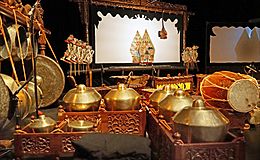
Gamelan musical instrument
|
|
| Country | Indonesia |
| Domains | Traditional craftsmanship, oral traditions and expressions, performing arts, knowledge and practices concerning nature and the universe, social practices, rituals and festive events |
| Reference | 01607 |
| Region | Asia and the Pacific |
| Inscription history | |
| Inscription | 2021 (16th session) |
| List | Representative List |
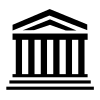 Gamelan variations consist of: Javanese gamelan (gamelan jawa) of Central Java and Special Region of Yogyakarta, Balinese gamelan (gamelan bali) of Bali, Sundanese gamelan (gamelan sunda) of West Java, Madurese gamelan (gamelan madura) and Banyuwangian Gamelan (gamelan banyuwangi) of East Java, Gendang beleq of West Nusa Tenggara, Banjarese gamelan (gamelan banjar) of South Kalimantan, Gamelan peking of Lampung, and Talempong of West Sumatra. Gamelan instruments: slab-type (wilahan) instruments (saron/sarun/pemade, demung/sarun ganal, Gendèr/kiliningan, slenthem/selentem/jegogan, peking/sarun paking/kantilan, kecrek/keprak), gong-type (pencon) instruments (gong, kempul, kenong, bonang, trompong, kethuk, talempong, kempyang), String instruments (siter, celempung, kecapi, rebab), Bamboo instrument (suling), Drums instruments (kendhang, Bedug, ketipung, gendang beleq), Wooden instrument (gambang) Idiophone instrument (kemanak) |
|
| Gamelan ensemble | |
|---|---|
| Stylistic origins | Music of Indonesia (Java, Sunda and Bali ) |
| Cultural origins | Indonesia |
| Typical instruments | |
Gamelan (pronounced GAM-uh-lan) is a type of traditional music from Indonesia. It's played by a group of musicians using many different instruments, mostly percussion ones. Imagine a whole orchestra of gongs, drums, and metal instruments!
The most common instruments are metallophones, which are like xylophones made of metal. Players hit them with mallets. Hand-played drums called kendhang keep the beat and control the speed of the music. Other instruments include xylophones, bamboo flutes (called suling), and string instruments like the rebab (a bowed instrument) and siter (a zither). Sometimes, singers called sindhen (female) or gerong (male) join in.
Even though pop music is popular now, gamelan is still a big part of Indonesian culture. It's played at many traditional events, like religious rituals, ceremonies, dances, and puppet shows. It's also used for singing, concerts, and festivals.
In 2014, the Indonesian government officially recognized gamelan traditions as an important part of their national heritage. Then, in 2021, UNESCO added gamelan to its list of Intangible Cultural Heritage of Humanity. This means it's considered a special cultural treasure that needs to be protected and shared with the world. UNESCO highlighted how gamelan helps people feel proud of their identity and promotes respect for each other.
There are different styles of gamelan, depending on where in Indonesia it comes from. The main ones are Javanese gamelan from Central Java, Balinese gamelan from Bali, and Sundanese gamelan from West Java. Each style has its own unique sound and instruments.
Contents
- What's in a Name? (Etymology)
- A Look Back in Time (History)
- Instruments of the Gamelan
- How Gamelan Music is Written (Notation)
- Different Kinds of Gamelan (Varieties)
- Gamelan in Culture
- How Gamelan is Made (Production)
- Gamelan's Impact on Music Around the World
- Gamelan in Modern Music and Media
- Gamelan Around the World
- Images for kids
- Gamelan on YouTube
- See also
What's in a Name? (Etymology)
The word gamelan comes from the Javanese word gamel, which means to play percussion instruments or to strike something with a mallet. The + an part is added to make it a noun.
In the Sundanese region, gamelan is often called Degung. This old Sundanese word refers to gongs and gong groups. So, Degung is basically another name for gamelan.
Another important word is karawitan. This term describes classical gamelan music and how it's performed. It comes from the Javanese word rawit, which means 'intricate' or 'finely made'. It refers to the smooth and elegant feeling in Javanese music. A skilled gamelan musician is called a pangrawit.
The formal Javanese word for gamelan is gangsa. This word might come from the materials used to make bronze gamelan instruments: tembaga (copper) and rejasa (tin). Or it could come from the numbers tiga (three) and sedasa (ten), referring to the mix of copper and tin (three parts tin to ten parts copper).
A Look Back in Time (History)
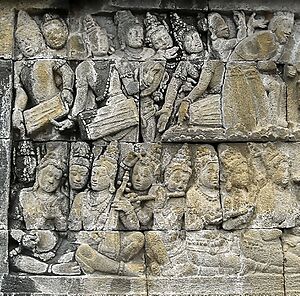
Gamelan music is very old, even older than the Hindu-Buddhist cultures that first appeared in Indonesia. This means it's a truly original Indonesian art form. While other arts were influenced by India, gamelan mostly kept its own unique style.
In Javanese stories, the god Sang Hyang Guru created the gamelan around 230 AD. He was the king of Java and needed a way to call the other gods. So, he invented the gong. To send more complex messages, he made two more gongs, creating the first gamelan set!
The oldest picture of a musical group like gamelan is found on the stone carvings of the 8th-century Borobudur Temple in Central Java. These carvings show musicians playing instruments like drums, flutes, cymbals, bells, and metal and wooden instruments. Many of these are still part of a gamelan orchestra today.
Gamelan instruments became what they are today during the Majapahit Empire. Old writings from that time show that the kingdom even had a special government office just for supervising performing arts, including gamelan. This office managed instrument making and scheduled performances for the royal court.

In Bali, some very old gamelan sets, like the Gamelan selunding, have been around since the 9th century. These are considered sacred and are used for important religious ceremonies in ancient temples.
In the royal courts of Java, the oldest known gamelan groups, Gamelan Munggang and Gamelan Kodok Ngorek, are from the 12th century. These are very special and sacred gamelan sets, kept as treasures by the Javanese courts. They are only played for important royal ceremonies like coronations, royal weddings, or to welcome important guests. Regular people are not allowed to own similar sets.
Over time, different styles of gamelan developed. A "soft style" grew from singing Javanese poetry, while the older court music was a "loud style." In the 17th century, these styles mixed, leading to the many different gamelan sounds we hear today in Bali, Java, and Sunda. Even with all the differences, they share many of the same ideas, instruments, and playing techniques.

A very special gamelan from the Demak Sultanate, called the gamelan Sakati, was given as a wedding gift in 1495. It's linked to the early days of Islam spreading in Java. This gamelan is still played today during special religious events at the Keraton Kasepuhan in Cirebon.
Another ancient gamelan, Gamelan Singo Mengkok, from the 15th century, is in Lamongan, East Java. It was used by Sunan Drajat (one of the Wali Sanga, important Islamic figures) to spread Islam. This gamelan mixed Hindu-Buddhist and Islamic cultures, making it easy for local communities to accept.
In the Islamic Mataram kingdom, two famous gamelan sets, Kanjeng Kyai Guntur Sari (1566) and Kanjeng Kyai Guntur Madu (1642), were made during the reign of Sultan Agung. These are also called Gamelan Sekati and are only played once a year for a week during the Sekaten ceremony, celebrating the Prophet Muhammad's birthday. Only royal family members and courtiers can play them, following strict rules.
An old gamelan called Gamelan Panglipur from the Kingdom of Sumedang Larang (17th century) was made to cheer up Prince Rangga Gede after his child died. This gamelan and nine others are kept in a museum in Sumedang. One of these, the Sari Oneng Parakansalak gamelan, even played at the opening of the Eiffel tower in Paris, France, in 1889!
In an amazing fact, Javanese gamelan music, specifically a piece called Gending ketawang puspawarna, was sent into space by NASA in 1977 on the Voyager I and Voyager II satellites. These satellites carry gold-plated disks with messages from Earth for any aliens who might find them. Gamelan music is literally out of this world!
Instruments of the Gamelan
A gamelan is a group of many different instruments that make various sounds. It includes metallophones (metal instruments), xylophones (wooden instruments), flutes, gongs, and stringed instruments. Voices are also often part of the ensemble.
The kendhang (hand-played drum) is super important. It controls the speed and rhythm of the music and signals when to change sections. One instrument usually plays the main melody, guiding the other players.
Javanese Gamelan Instruments
In Java, there are two main types of gamelan: Pakurmatan and Ageng.
- Gamelan Pakurmatan is used for very special and sacred royal events. These sets are often unique and kept in palaces.
- Gamelan Ageng is the most complete type of gamelan and is commonly owned by artists, schools, and communities. It's used for many traditional ceremonies and performances, both inside and outside the palace.
A full set of Javanese Gamelan Ageng includes many instruments. Here are some of the main ones:
- Bonang: Sets of small gongs played with mallets.
- Kenong: Large, bowl-shaped gongs that sit on frames.
- Kethuk and Kempyang: Smaller gongs that keep a steady beat.
- Slenthem: A metallophone with thin metal keys, played with a mallet.
- Gendèr: A metallophone with thin metal keys hanging over tubes, played with soft mallets.
- Saron: Metallophones with thick metal keys, played with a wooden mallet. There are different sizes: Demung (low), Barung (medium), and Peking (high).
- Gong Ageng: The largest gong, marking the end of major musical phrases.
- Gong Suwukan: Smaller gongs that also mark musical phrases.
- Kempul: Medium-sized hanging gongs.
- Kendhang: Drums that control the tempo. There are different types like Ageng, Ciblon, Sabet, and Ketipung.
- Bedug: A large drum, often used in mosques.
- Rebab: A two-stringed bowed instrument.
- Gambang: A wooden xylophone.
- Siter and Celempung: Zither-like string instruments.
- Suling: A bamboo flute.
- Kecer and Kepyak: Small metal percussion instruments.
- Sindhen: Female singers.
- Gerong: Male singers.
- Nayaga (Wiyaga): The gamelan musicians.
- Typical Javanese Gamelan Instruments
Balinese Gamelan Instruments
In Bali, gamelan instruments are kept in a balé, which is a large open building with a roof. These instruments are usually owned by a banjar (a community group), noble families, or temples. They are kept together because people believe the instruments belong to the whole community.
The open walls of the balé let the music flow out to everyone. Balinese gamelan can be very loud, so it's best heard in open spaces!
A gamelan group in Bali is called a sekaha. It's led by an instructor who creates new music. When they practice, the group often improvises, meaning they make up parts of the music as they go along. This makes the music always fresh and changing, except for very sacred songs which stay the same. It can take months to finish a new piece! Usually, men and women play in separate groups.
A complete Balinese gamelan ensemble includes:
- Reyong: A set of small gongs played by several people at once.
- Trompong: Similar to a bonang, with gongs arranged in a row.
- Gong Wadon and Gong Lanang: Large gongs, often played as a pair.
- Gong Kempur, Gong Klentong, Gong Bende: Various other gongs.
- Kenong (Kajar): Gongs that keep the beat.
- Kethuk (Kempli): Small gongs for rhythm.
- Jiyèng (Ugal), Gangsa (Pemande), Kanthilan: Types of metallophones.
- Jublag and Jegogan: Larger metallophones with deeper sounds.
- Penyacah Kenyur: Another type of metallophone.
- Gendèr Rambat: A metallophone similar to the Javanese gendèr.
- Cèng-cèng Ricik and Cèng-cèng Kepyak: Small cymbals.
- Kendhang Semaradana and Kendhang Batel: Drums.
- Gentorak: A small bell tree.
- Suling: Bamboo flutes.
- Nayaga (Wiyaga): The gamelan musicians.
How Gamelan Music is Written (Notation)
The way gamelan instruments are tuned and built is very complex. Javanese gamelan uses two main tuning systems: sléndro and pélog.
- Sléndro has five notes in an octave, with wide gaps between them. It often sounds light and cheerful.
- Pélog has seven notes in an octave, with uneven gaps. It can sound more serious or sacred.
A full gamelan set will have instruments for both tunings. Usually, only one tuning is used at a time. The exact tuning can be a little different for each gamelan group, giving each one its own special sound.
In Balinese gamelan, instruments are often built in pairs. These pairs are tuned slightly apart to create a shimmering, "wavy" sound called "ombak." This sound is meant to represent the beating of a heart and is important in religious ceremonies, helping listeners feel a connection to the divine.
Javanese gamelan also uses something called Irama, which combines tempo (speed) and density (how many notes are played).
Slendro Tuning
Slendro tuning often creates a light, happy feeling. It's used in scenes like wars or marches in wayang kulit (shadow puppet plays) and wayang wong (dance-drama). But it can also be used for sad or romantic scenes, especially when notes are played slightly out of place on purpose.
Pelog Tuning
Pelog tuning often sounds strong, royal, and sacred. It's used for scenes where a king enters a holy place, or for feelings like anger or revenge. However, depending on how it's played, pelog can also sound happy and lively.
Kepatihan Notation
Traditionally, gamelan music wasn't written down; it was learned by listening and memorizing. But in the 1800s, royal palaces in Java created ways to write down the music, mainly to keep records.
Today, a system called kepatihan notation is commonly used. It uses numbers for pitches (notes) and dots or lines to show how high or low they are, and how long they last. This notation mainly records the main melody. The other parts are played by musicians who know their instruments well and listen to what everyone else is playing. This is called "garap."
Different Kinds of Gamelan (Varieties)
Gamelan groups are different based on their instruments, singing, tunings, songs, style, and cultural meaning. No two gamelan groups are exactly alike! Groups from famous royal courts often have their own special style.
Gamelan types are usually grouped by where they come from. The main ones are from Bali, Java, and Sunda.
- Javanese gamelan usually has soft and slow sounds, showing a calm and harmonious feeling.
- Balinese gamelan is strong and lively, with fast rhythms.
- Sundanese gamelan often features flutes, making it sound soft and sometimes a bit sad.
Javanese Gamelan
Javanese gamelan comes from Central and East Java, including the area of Yogyakarta. As mentioned, there are royal gamelan sets (pakurmatan) and more common ones (ageng). The common gamelan ageng sets are used for many traditional ceremonies and events.
There are many kinds of Javanese gamelan used by communities, like gamelan gadhon, gamelan siteran, and gamelan bambu. Each has its own special use and sound.
Gamelan is a deep part of Javanese life and customs. It's almost always present at Javanese ceremonies. It's used to go along with dances, dance-dramas, theater, and puppet shows. It has also grown to be a performance on its own, with singers.
Most Javanese gamelan music has soft rhythms, showing the peaceful way of life in Javanese society. Some pieces are faster, depending on the event. Javanese gamelan uses both pelog and slendro tunings.
- Javanese gamelan
Balinese Gamelan
Balinese gamelan is a traditional music group from the island of Bali. It's a huge part of Balinese life, with almost every village having its own gamelan. It's used for Hindu worship and for community entertainment. Playing gamelan needs teamwork, as players work together to create a beautiful harmony of sounds.
Balinese gamelan is often used to accompany religious ceremonies and performances. It adds spirit and beauty to dances and shows. There are three main types of Balinese gamelan based on their age:
- Gamelan wayah: Very old gamelan (before the 15th century), often without drums.
- Gamelan madya: From the 16th-19th centuries, where drums started to play a bigger role.
- Gamelan anyar: Newer types from the 20th century, often featuring strong drum playing.
- Balinese Gamelan
-
Balinese gamelan being played in Kuta, Bali, Indonesia, on 23 September 2010.
Sundanese Gamelan
The Sundanese gamelan comes from West Java and Banten province. It's also called Degung. Some say the name Degung came from "Ratu-agung" or "Tumenggung" because officials really liked it.
There are three types of Sundanese gamelan:
- Gamelan salendro: Often used for puppet shows, dances, and other performances. It's very popular.
- Gamelan renteng: An older type of gamelan, possibly where modern Sundanese gamelan started.
- Gamelan ketuk tilu: Used for dances like ketuk tilu and doger, and mask dances.
- Sundanese Gamelan
-
Sundanese Gamelan Degung Performance from West Java, Indonesia, on 6 November 2007.
Gamelan has also spread beyond Indonesia through people moving and cultural interest. New styles have even appeared. You can find gamelan groups in over 25 countries around the world!
Gamelan in Culture
For many Indonesians, gamelan has deep meaning. It's not just about playing instruments together to make beautiful music. It also shows the spirit of working together and making decisions as a group, like how each instrument plays its part to create harmony. Gamelan symbolizes togetherness and cooperation in society.
Gamelan is used in many cultural activities in Indonesia:
Religious Rituals
Gamelan has been used in religious ceremonies for a long time, especially with singing and puppet shows. In old writings from the 14th century, it's mentioned that gamelan music was used by King Hayam Wuruk for a mask dance. When Islam spread, gamelan became a way to share Islamic teachings.
Gamelan is so important in rituals that there's a Javanese saying: "It is not official until the gong is hung." Some performances are linked to royalty, like visits from the sultan of Yogyakarta. Special gamelan sets, like the Gamelan Sekaten, are used for specific celebrations, such as the Prophet Muhammad's birthday. In Bali, almost all religious rituals include gamelan. It's even used in Catholic church ceremonies in Indonesia!
Some gamelan pieces are believed to have magical powers and can be used to protect against bad spirits.
- Some religious rituals in Indonesia that use gamelan as an accompaniment
Traditional Ceremonies
Gamelan is used for many traditional ceremonies in Indonesia. Sacred gamelan sets like kodhok ngorek and monggang are used for important royal events in the Yogyakarta and Surakarta palaces, such as:
- King's coronations
- King's birthday celebrations
- Royal guest receptions
- Baby birth ceremonies
- Weddings
- Funerals for royal family members
Outside the palace, gamelan is used for Wedding receptions, rice harvesting ceremonies, and other community events.
- Some Indonesian traditional ceremonies that use gamelan as an accompaniment
Traditional Dances
Almost all dances from Java and Bali are performed with gamelan music. Gamelan adds spirit and beauty to live dance shows. The music guides the dancers with its rhythm and tempo. The choice of music must match the dance's rhythm and theme.
Dance performances with live gamelan are complex art forms. The gamelan music helps create the right mood and tells the story. It's like the music "talks" and works perfectly with the dance. Often, gamelan players know dance moves, and dancers can play instruments.
Famous dances that use gamelan include: bedhaya, serimpi, legong, jaipong, and barong.
- Some Indonesian Traditional dance that use Gamelan as an accompaniment
Dance-Drama Performances
Dance-drama in Indonesia combines dance and acting to tell a story. Sometimes there's dialogue, sometimes not. A puppeteer often guides the show. Gamelan music always accompanies these performances, and the many performers wear special costumes.
Gamelan music is used to create the right mood and illustrate the story. It makes the show more interesting and helps the dance and music flow together perfectly.
Examples of dance-dramas include: wayang wong, wayang topeng, and Ramayana Ballet.
- Some Dance drama performances that use gamelan as an accompaniment
-
Ramayana Ballet Performance near Prambanan Temple complex in Yogyakarta, Indonesia.
Wayang Puppet Performances
Gamelan is used to accompany all kinds of puppet shows, like wayang kulit (shadow puppets) and wayang golek (wooden puppets). The dalang (puppeteer) needs to know a lot about gamelan, as they give the signals for the music.
Gamelan helps create the atmosphere the dalang wants for the puppet show. The music changes between pelog and slendro tunings to match the mood of each scene. Gamelan music helps share the stories and lessons in puppet shows.
- Some Wayang Puppet Show that use Gamelan as an accompaniment
Traditional Theater Performances
Traditional theater, especially in Java and Bali, is mostly accompanied by gamelan. Plays like kethoprak, ludruk, and sandiwara use gamelan to make the show more lively.
- Ketoprak is a traditional theater from Central Java, often telling stories about Javanese palaces and noble families.
- Ludruk from East Java tells stories about everyday people and their struggles. All performers in ludruk are male, even for female roles.
- Sandiwara is a traditional drama from West Java.
- Some traditional theatre performance that use gamelan as an accompaniment
Singing Performances
Gamelan can be played on its own, without dance or drama, in a style called "klenengan." Gamelan concerts are common in arts schools. Gamelan music is also often played on the radio. For example, the Pura Pakualaman gamelan plays live on the radio every 35 days.
In Java, gamelan is often played in a pendopo, which is an open pavilion with a high roof. The instruments are placed on a platform so the sound can echo and sound even better.
Traditional singing styles like javanese poetry and tembang sunda are often accompanied by gamelan.
- Some Traditional singing performance that use gamelan as an accompaniment
Festivals
Many festivals in Indonesia use gamelan to make the events lively. Sometimes, gamelan is the main theme of the festival! Several gamelan festivals are held regularly, such as the Gamelan festival in Solo and the Yogyakarta International Gamelan Festival.
- Some Festivals in Indonesia
-
Gamelan performance at the Borobudur International Performances and Art Festival 2018.
How Gamelan is Made (Production)
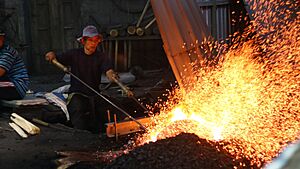
Most metal gamelan instruments are made from bronze, brass, or iron. Some parts are made from wood, bamboo, leather, and strings. The best gamelan is made from bronze, which is a mix of ten parts copper and three parts tin.
A "Pande" is a gamelan maker, and a "Pelaras" is someone who tunes the gamelan. Making a good gamelan involves at least five steps:
- Membesot: Melting the metals in a special clay pot called a kowi. This needs a very hot fire.
- Menyinggi: Melting the metal again and shaping it into flat blades or round shapes. Sometimes, flower water is used to soak the newly shaped metal for sacred reasons.
- Menempa: Forging or shaping the metal to get the perfect form. This is the most difficult step and needs skilled craftsmen who use different hammers and hitting techniques.
- Membabar: Checking the forged gamelan for any flaws and fixing them.
- Melaras: Tuning the instruments to make sure they have the correct musical scales. This is very important for the gamelan to sound perfect.
After these steps, the metal parts are put into their frames. Some craftsmen also perform rituals like fasting or giving offerings while making gamelan. This is to make sure the instruments are perfect not just in how they look and sound, but also in their spiritual meaning.
Gamelan making centers are found across Java and Bali. These places have sent hundreds of gamelan sets all over the world!
Gamelan's Impact on Music Around the World
Many Western classical music composers have been inspired by gamelan. A famous example is Claude Debussy, who heard Javanese gamelan at the Paris World's Fair in 1889. While he didn't copy gamelan exactly, its sounds influenced his music, especially in pieces like "Pagodes."
Another composer, Erik Satie, also heard gamelan at the same event. The repeating, almost hypnotic sounds of gamelan influenced his piano pieces called Gnossienne.
Many other composers have used gamelan in their works, either by writing for gamelan instruments or by using gamelan-like sounds. These include John Cage, Béla Bartók, Olivier Messiaen, and Benjamin Britten. Some composers, like Colin McPhee and Lou Harrison, even traveled to Indonesia to study gamelan deeply.
In jazz, the trumpeter Don Cherry was influenced by gamelan in his 1968 album Eternal Rhythm.
Even rock and electronic music have felt gamelan's influence! The band King Crimson used gamelan-like interlocking guitar rhythms. The British musician Mike Oldfield used gamelan sounds in several of his songs. Experimental pop groups like The Residents and 23 Skidoo (whose album was even called Urban Gamelan) have also used gamelan percussion.
Gamelan in Modern Music and Media
In Indonesia today, some music groups mix traditional gamelan with modern Western styles like jazz fusion. Bands like Krakatau and SambaSunda combine Sundanese gamelan with drums, keyboards, and guitars. Other bands mix Javanese music with bossa nova or jazz with Balinese gamelan.
The Indonesian singer Anggun often uses traditional Indonesian sounds, including gamelan, in her songs. You can hear gamelan in her album Snow on the Sahara and in her collaborations with the group Deep Forest.
Gamelan has also influenced Japanese popular music, especially the synthpop band Yellow Magic Orchestra. Their 1981 album Technodelic used gamelan sounds and samples. One of their members, Ryuichi Sakamoto, also used gamelan for his soundtrack to the 1983 film Merry Christmas, Mr. Lawrence, winning an award for it.

Many people first heard gamelan in the popular 1988 Japanese anime film Akira. Gamelan sounds are used in the film's exciting fight scenes and to show the main character's growing psychic powers. Gamelan and kecak (a Balinese vocal chant) are also used in video game soundtracks like Secret of Mana and Sonic Unleashed.
The TV series Battlestar Galactica and films like Girl with a Pearl Earring and The Golden Compass also feature gamelan music. For Disney's 2001 film Atlantis: The Lost Empire, gamelan was chosen as the musical theme for the Atlanteans.
Gamelan music loops appear in electronic music, too. And in the cartoon Regular Show, a gamelan is mentioned as part of a huge drum kit!
Gamelan Around the World
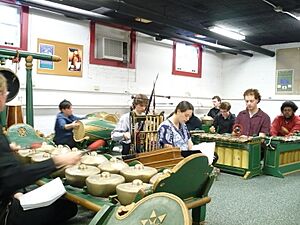
Gamelan is well-known both in Indonesia and in many other countries. There are many gamelan groups outside Indonesia. This happened because Indonesian people (Javanese, Balinese, or Sundanese) moved to other countries and shared their culture. The Indonesian government also actively promotes gamelan abroad, offering scholarships for foreign students to learn it.
Indonesia has exported hundreds of gamelan sets worldwide. You can find gamelan in almost every continent, including North and South America, Europe, Asia, Australia, and New Zealand!
- Some of the gamelan Groups Outside Indonesia
-
Kyai Barleyan, a Javanese gamelan at Oberlin College in Ohio. Acquired in 1970, it is believed to be the third-oldest gamelan in use in the United States.
-
Gamelan Son of Lion, a Javanese-style iron American gamelan based in New York City that is devoted to new music, playing in a loft in SoHo, Manhattan, United States in 2007.
-
Sundanese Gamelan Degung being played in Museo Nacional de las Culturas Mexico, by the Indra Swara Gamelan Group, on 2 April 2018.
Images for kids
-
The Sundanese Jaipongan dance performance accompanied by Gamelan Ensemble in West Java Pavilion, Taman Mini Indonesia Indah, Jakarta.
-
Gamelan Nyi Asep Mangsa, Indra Swara, México, on 27 March 2015.
Gamelan on YouTube
Introduction to gamelan
- [Module] – Gamelan Ensemble 01 – (https://www.youtube.com/watch?v=wW2swV6vrjs&list=WL&index=114)
- [Module] – Gamelan Ensemble 02 – (https://www.youtube.com/watch?v=PR57S_gic48&t=71s)
- [Module] – Gamelan Ensemble 03 – (https://www.youtube.com/watch?v=c1AiCTJ9t8g&t=59s)
- [Module] – Gamelan Ensemble 04 – (https://www.youtube.com/watch?v=GsPdTNGnr44&t=302s)
- [Module] – Gamelan Ensemble 05 – (https://www.youtube.com/watch?v=dmzxonGucJc)
- [Module] – Gamelan Ensemble 06 – (https://www.youtube.com/watch?v=jE93bF0dooU&t=53s)
- [Module] – Gamelan Ensemble 07 – (https://www.youtube.com/watch?v=Il5nGXComn0)
- [Ancient video] – Gamelan and legong dance – (https://www.youtube.com/watch?v=S8jLaGs9EyM)
- [Ancient video] – gamelan and wayang puppet theater – (https://www.youtube.com/watch?v=KUOSltOetNI)
Javanese gamelan
- [Royal Ceremony] – King Coronation Ceremony of Yogyakarta Sultanate accompanied by Gamelan Khodok Ngorek and Gamelan Munggang (Sacred Gamelan) on 7 March 1989 – (https://www.youtube.com/watch?v=FSkHg_RTCN8)
- [Royal Ceremony] – King Coronation Anniversary accompanied by Bedhaya Ketawang (Sacred) Dance and Gamelan Ensemble in Surakarta Sunanate – (https://www.youtube.com/watch?v=-s21OGopAQc&t=279s)
- [Religious Rituals] – Sekaten Rituals accompanied by Gamelan Sekati (Sacred Gamelan) named Kanjeng Kyai Nagawilaga in front of Grand Mosque of Yogyakarta Sultanate – (https://www.youtube.com/watch?v=G_cAnUo66-A)
- [Religious Rituals] – Sekaten Rituals accompanied by Gamelan Sekati (Sacred Gamelan) named Kyai Guntur Sari in front of Grand Mosque of Surakarta Sunanate – (https://www.youtube.com/watch?v=czkm8VePq9A)
- [Traditional Ceremony] – Javanese Wedding (Solo Basahan) Ceremony accompanied by Gamelan Ensemble – (https://www.youtube.com/watch?v=pBtSbrRG13g&list=WL&index=113)
- [Traditional Ceremony] – Javanese Wedding (Solo Putri) Ceremony accompanied by Gamelan Ensemble – (https://www.youtube.com/watch?v=Njb_Md-pxwQ&lc=UgysBy0qA2SR5RpUI-x4AaABAg.9GxKxP0toYC9GzR6Ez2Dve)
- [Traditional Dance] – Bedhaya Sapto Dance accompanied by Gamelan Ensemble – (https://www.youtube.com/watch?v=yTc2Z9MqhZQ&t=3729s)
- [Traditional Dance] – Bedhaya Parthakrama Dance accompanied by Gamelan Ensemble – (https://www.youtube.com/watch?v=55JWE0if4ZM&t=1473s)
- [Traditional Dance] – Bedhaya Harjuna Wiwaha Dance accompanied by Gamelan Ensemble – (https://www.youtube.com/watch?v=S2uDmlAOHnI&t=540s)
- [Traditional Dance] – Srimpi Ludiro Madu Dance accompanied by Gamelan Ensemble – (https://www.youtube.com/watch?v=axb5ANHuWFg)
- [Traditional Dance] – Srimpi Sangupati Dance accompanied by Gamelan Ensemble – (https://www.youtube.com/watch?v=AwYvlaqb_uY)
- [Traditional Dance] – Srimpi Pandelori Dance accompanied by Gamelan Ensemble – (https://www.youtube.com/watch?v=wQwQPKjX8aE&t=1211s)
- [Traditional Dance] – Gambyong Pareanom Dance Performance accompanied by Gamelan Ensemble – (https://www.youtube.com/watch?v=axb5ANHuWFg)
- [Traditional Dance] – Some Javanese dance and Gamelan Ensemble Performance 01 by Soerya Soemirat Mangkunegaran Royal Palace – (https://www.youtube.com/watch?v=eT-wT5KbFec)
- [Traditional Dance] – Some Javanese dance and Gamelan Ensemble Performance 02 by Soerya Soemirat Mangkunegaran Royal Palace – (https://www.youtube.com/watch?v=_c9XhHN3pFU)
- [Traditional Dance] – Some Javanese dance and Gamelan Ensemble Performance 03 by Soerya Soemirat Mangkunegaran Royal Palace – (https://www.youtube.com/watch?v=0tzecUzbWFM)
- [Traditional Dance-Drama] – Ramayana Ballet accompanied by Gamelan Ensemble in Prambanan Temple – (https://www.youtube.com/watch?v=99fLb5SpH2w)
- [Traditional Dance Drama] – Wayang wong of Mahabharata and Gamelan Ensemble Performance 01 by Soerya Soemirat Mangkunegaran Royal Palace – (https://www.youtube.com/watch?v=fxy8ejXA7Mk)
- [Traditional Dance Drama] – Wayang wong of Mahabharata and Gamelan Ensemble Performance 02 by Soerya Soemirat Mangkunegaran Royal Palace – (https://www.youtube.com/watch?v=8m6Cmz7VGds)
- [Wayang Puppet Theater] – Gamelan Ensemble Performance for beginning of War in Wayang Kulit by Seno Nugroho – (https://www.youtube.com/watch?v=PxzcCnubcH0)
- [Wayang Puppet Theater] – Wayang Kulit Performance accompanied by Gamelan Ensemble by Ki Manteb Sudarsono – (https://www.youtube.com/watch?v=GQ8e4ujuMkM)
- [Wayang Puppet Theater] – Wayang Kulit Performance accompanied by Gamelan Ensemble by Ki Bayu Aji – (https://www.youtube.com/watch?v=w01cFPeUrtA&t=261s)
- [Traditional Singing] – Javanese Singing (Sacred Song) and Gamelan Ensemble Performance 01 by Soerya Soemirat Mangkunegaran Royal Palace – (https://www.youtube.com/watch?v=SCxYHjx1xew)
- [Traditional Singing] – Javanese Singing and Gamelan Ensemble Performance 02 by Soerya Soemirat Mangkunegaran Royal Palace – (https://www.youtube.com/watch?v=YXMiUIZJ-Qk)
- [Traditional Singing] – Gamelan Ensemble Performance of Yogyakarta Sultanate in International Gamelan Festival 2018 in Solo, Central Java – (https://www.youtube.com/watch?v=PiMHtaGI-gs)
- [Traditional Singing] – Gamelan Ensemble Performance with Islamic Song by Ki Enthus Susmono – (https://www.youtube.com/watch?v=nBhKCfv8vK8)
- [Traditional Singing] – Gamelan Ensemble Performance by ISI Yogyakarta (Indonesian Institute of the Arts, Yogyakarta)- (https://www.youtube.com/watch?v=16_nS0nkWUs&t=578s)
- [Traditional Singing] – Gamelan Ensemble Performance by Nurroso Surakarta (Blacius Subono) – (https://www.youtube.com/watch?v=fB5h3QnuN0s)
Balinese gamelan
- [Traditional Music] – Balinese gamelan performance in front of a temple, Bali, Indonesia – (https://www.youtube.com/watch?v=UEWCCSuHsuQ&t=14s)
- [Traditional Music] – Balinese gamelan performance in Puri Saren Ubud, Bali, Indonesia – (https://www.youtube.com/watch?v=IXZ2nkj9W4Y&t=253s)
- [Traditional Music] – Balinese gamelan performance, Tabuh Telu Gesuri in Tabanan, Bali, Indonesia – (https://www.youtube.com/watch?v=LsNMbCYOdK0)
- [Traditional Dance] – Sanghyang Dedari gance (Balinese sacred dance) accompanied by Balinese Gamelan (as part of ritual) inside the Temple in Sukawati, Bali, Indonesia – (https://www.youtube.com/watch?v=rKvb6BWxAwM)
- [Traditional Dance] – Balinese Topeng dance Performance (Topeng Dalem Sidhakarya) accompanied by Balinese Gamelan inside the Uluwatu Temple, Bali, Indonesia – (https://www.youtube.com/watch?v=MEBWFgcLAnE)
- [Traditional Dance] – Legong Lasem dance performance accompanied by Balinese gamelan in Puri Saren Ubud, Bali, Indonesia – (https://www.youtube.com/watch?v=A8K9fo7DoB8)
- [Traditional Dance] – Oleg Tamulilingan dance performance accompanied by Balinese gamelan in Bali Arts Festival, Bali, Indonesia – (https://www.youtube.com/watch?v=hVafWnY1sOs)
- [Traditional Dance] – Sekar Jepun Dance Performance accompanied by Balinese Gamelan in Badung, Bali, Indonesia – (https://www.youtube.com/watch?v=EcguDzBEwQE)
- [Traditional Dance] – Barong Dance Performance accompanied by Balinese Gamelan in Ubud, Bali, Indonesia – (https://www.youtube.com/watch?v=43mJBtqcrjA)
- [Traditional Dance] – Baris dance Performance accompanied by Balinese Gamelan in Ubud, Bali, Indonesia – (https://www.youtube.com/watch?v=I4BJA0hRzkc)
- [Traditional Dance] – Pendet dance Performance accompanied by Balinese Gamelan in Ubud, Bali, Indonesia – (https://www.youtube.com/watch?v=exJkGtK2Bbo)
- [Traditional Dance] – Taruna Jaya Dance Performance accompanied by Balinese Gamelan in Bali Arts Festival, Bali, Indonesia – (https://www.youtube.com/watch?v=qrMm_iHdJzg)
- [Traditional Dance] – Cendrawasih dance Performance accompanied by Balinese Gamelan in Bali Arts Festival, Bali, Indonesia – (https://www.youtube.com/watch?v=J9Sn08gJgIQ&t=209s)
- [Religious Rituals] – Balinese Gamelan in Odalan Rituals inside a temple, Bali, Indonesia – (https://www.youtube.com/watch?v=-9EuLETmHSs)
- [Religious Rituals] – Ngaben (Balinese Cremation Ceremony) in Ubud, Bali, Indonesia – (https://www.youtube.com/watch?v=n4fvkL8LMO4&t=1206s)
- [Religious Rituals] – Ogoh-ogoh (Balinese purification of the natural environment of any spiritual pollutants) in Bali, Indonesia – (https://www.youtube.com/watch?v=3P4riu9LhfA)
- [Wayang Puppet Theater] – Balinese Wayang Kulit with Gamelan, Bali, Indonesia – (https://www.youtube.com/watch?v=K9PQcvM-c30)
Sundanese gamelan
- [Traditional Singing] – Sundanese Singing Performance 01 accompanied by Sundanese Gamelan – (https://www.youtube.com/watch?v=yWsAXJznHts)
- [Traditional Singing] – Sundanese Singing Performance 02 accompanied by Sundanese Gamelan – (https://www.youtube.com/watch?v=_tv8sxHP71Q)
- [Traditional Dance] – Jaipong Dance Performance accompanied by Sundanese Gamelan – (https://www.youtube.com/watch?v=bNU5HvzySRQ)
- [Traditional Dance] – Bajidor Kahot Dance Performance accompanied by Sundanese Gamelan – (https://www.youtube.com/watch?v=SiM0iG9-N_I)
- [Traditional Dance] – Jaipong Keser Bojong Dance Performance accompanied by Sundanese Gamelan – (https://www.youtube.com/watch?v=7iGDKqBQWw0)
- [Traditional Dance] – Losari Topeng Dance (Cirebonese mask dance) Performance accompanied by Gamelan – (https://www.youtube.com/watch?v=3FzFtG-klBg&t=1709s)
- [Traditional Dance] – Klana Topeng Dance (Cirebonese mask dance)Performance accompanied by Gamelan – (https://www.youtube.com/watch?v=sMi6RF6EbtA)
- [Traditional Dance] – Tumenggung Topeng Dance (Cirebonese mask dance)Performance accompanied by Gamelan – (https://www.youtube.com/watch?v=ISNd4PbHFTc)
- [Wayang Puppet Theater] – Wayang Golek Performance accompanied by Sundanese Gamelan – (https://www.youtube.com/watch?v=i008pVUhAsk)
- [Wayang Puppet Theater] – Opening Wayang Golek Performance accompanied by Sundanese Gamelan – (https://www.youtube.com/watch?v=4u-0Pa3fGF4&list=WL&index=13)
- [Religious Rituals] – Sekaten Rituals in Kraton Kanoman accompanied by Sundanese Gamelan – (https://www.youtube.com/watch?v=JuT1WCPNPJM&t=954s)
Contemporary gamelan
- [Javanese Gamelan] – Penataan Ghending Bumi Pusaka by Nurroso Surakarta (Blacius Subono) – (https://www.youtube.com/watch?v=o7sQiC06QCo)
- [Javanese Gamelan] – Gamelan and Brass Collaraboration by Prawiratama Indonesia in Taman Budaya Yogyakarta – (https://www.youtube.com/watch?v=VEfgt9XgMN8&list=PLBibCSfGEfKgdXVzXYRjpeOF94-mPnWO2&index=1&t=597s)
- [Javanese Gamelan] – Konser Gebyar Gamelan Mbabar Kebangsaan by Nurroso Surakarta (Blacius Subono) – (https://www.youtube.com/watch?v=Q6K9xdG3aZ4&t=562s)
- [Javanese Gamelan] – Lindur Gamelan Performance by students of Gadjah Mada University – (https://www.youtube.com/watch?v=oha1VudG8Y)
- [Javanese Gamelan] – Javanese children song with Gamelan Ensemble Performance by students of State University of Semarang – (https://www.youtube.com/watch?v=kIiQW3Xs1wc)
- [Javanese Gamelan] – Y in Penta Performance by Gamelan Rock Indonesia at Yogyakarta Gamelan Festival 2012 – (https://www.youtube.com/watch?v=9CwyWDS6iE8)
- [Javanese Gamelan] – Indonesian Ethnic Songs and Electronic Dance Music Performance by Alffy Rev ft Kecubung Sakti Karawitan – (https://www.youtube.com/watch?v=FF4GB3itpAk&list=PLBibCSfGEfKgdXVzXYRjpeOF94-mPnWO2&index=3)
- [Balinese Gamelan] – Cak Dag Song by Smarandhana Contemporary Music Bali – (https://www.youtube.com/watch?v=j41SHGAK480&list=PLBibCSfGEfKgdXVzXYRjpeOF94-mPnWO2&index=4)
- [Balinese Gamelan] – Indonesian ethnic song by Collaboration between Bali Musik Etnik and Don Biu at Nawanatya 2017 – (https://www.youtube.com/watch?v=AwE6owHYVYc)
- [Sundanese Gamelan] – Putih Abu-abu, Sanggar Smansaku, and Sanggar Bina Budaya covering Weird Genius –- Lathi (ft. Sara Fajira) – (https://www.youtube.com/watch?v=Jsr1of9ITMo)
- [Sundanese Gamelan] – SambaSunda performing Bangbung Hideung as part of Jazz Gunung 2016 at Jiwa Jawa Resort Bromo, East Java – (https://www.youtube.com/watch?v=OsPsxCFgdlw&list=RD-hIeq9nPzGc&index=2)
- [Sundanese Gamelan] – Music of West Java as part of Parade Musik Daerah 2017 at Taman Mini Indonesia Indah Jakarta – (https://www.youtube.com/watch?v=bzV_gVX90Mo&list=PLBibCSfGEfKgdXVzXYRjpeOF94-mPnWO2&index=20)
- [Sundanese Gamelan] – Siuh in Gamelan Ensemble Performance by SambaSunda from Bandung – (https://www.youtube.com/watch?v=OZ1ULCabGqQ)
- [Sundanese Gamelan] – Taramurag in International Gamelan Festival Solo 2018 by SambaSunda from Bandung – (https://www.youtube.com/watch?v=JihLg6fEVEM)
- [Sundanese Gamelan] – SambaSunda performing as part of the International Gamelan Festival 2018 in the city of Surakarta – (https://www.youtube.com/watch?v=-hIeq9nPzGc)
- [Sundanese Gamelan] – Gending Sari Karawang performing as part of Festival Kolaborasi Etnik 2017 in the city of Garut – (https://www.youtube.com/watch?v=95TgXJ-0mvU)
See also
 In Spanish: Gamelán para niños
In Spanish: Gamelán para niños


